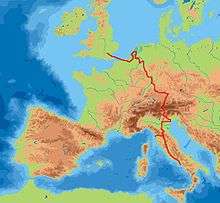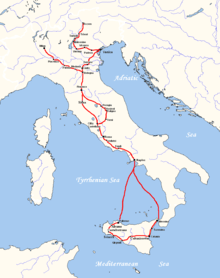Grand Tour
In early modern Europe, the Grand Tour was an educational journey undertaken by an elite of young men, and in some cases women, who could be sponsored by wealthy parents, or other benefactors.
- This article is an itinerary.
Understand
The Grand Tour became customary among British noblemen in the 17th century, following the end of Thirty Years War, the English Civil War, and associated wars. With the Westphalian Treaty, peace became the rule, rather than the exception, in Europe. While the tourists were guided by a cicerone, the wealthiest could travel with a staff of servants. Tourists had opportunities to learn languages such as French and Italian, see works of European art (and have themselves portrayed by a painter), listen to European classical music, and see classical architecture. They could also practice gentlemen's sports, such as horse riding and fencing.
While the Tour was not a religious voyage in itself, tourists from Catholic families visited the Vatican, while the Protestants often saw locations of the Protestant Reformation, such as Geneva and Lausanne.
The Grand Tour coined the word tourist. The tradition declined in the 19th century, as steam ships and railways made travelling more mundane, and other destinations became more popular; modern nationalism and imperialism encouraged Europeans to seek out nature and culture within their own countries, or to explore overseas colonies and dominions.
A similar tradition for artisans without wealth or noble birth was the journeyman years, when they travelled around Europe, usually on foot, to practice their craft, typically for three years or x years and x days. This custom, with the surrounding ceremonies, is still alive in Germany.
A much less elitist but somewhat related concept is "doing Europe" as many young North Americans put it - a short trip of Europe making pit stops at the most postcard-worthy highlights, but few things in between. Young Europeans themselves might spend a summer seeing much of the continent on European rail passes, while the rise of no-frills aviation has made trips around Europe accessible to ever more people.
Get around
The typical tourists rode a horse cart around Europe. While roads improved during the centuries, travel remained slow, expensive and risky, until the advent of railroads in the 19th century. Today of course the situation has vastly changed with Europe home to some of the best railroads, cheapest airlines and best maintained roads in the world. There is no reason besides masochism to take a horse cart these days, and on many roads it would not actually be street-legal. While the sleeper train that used to be a mainstay of Interrailers of days past has undergone a slow but seemingly terminal decline in most of the area this article covers, high speed rail enables you to breakfast in Paris, take a coffee in Frankfurt and be in Berlin by dinnertime or many other such trips and early booking as well as some flexibility can net you rates that people in the 18th century would have had a duel over. Road tolls range from the substantial in places like France to the nominal to zero in places like Germany and while their purpose is no longer to pay the patrols against highwaymen, streets are safer than they have been in decades if not centuries.
Crossing the Alps was a daunting task and it often influenced the itineraries taken. Some even disassembled or sold their carriage ahead of the crossing. Today the crossing can be done in a few hours on a train or plane, but going by car in the summer, the passes and tunnels are still rather prone to congestion. There are still well maintained hiking paths with centuries of history crossing the Alps that offer breathtaking views in exchange for strenuous hikes. Legendary mountain-passes like the St. Gotthard or the Brenner have been tunneled under or are in the process of being tunneled under. Sometimes there is a tunnel dating to the 19th or early 20th century which is now being replaced or supplemented by a "base tunnel" at a lower level. Even the Unesco world heritage listed Semmering Railway is in the process of having a base tunnel built underneath, with the once important alpine crossing relegated to a touristic and local line.
Go

United Kingdom
🌍 Cambridge and 🌍 Oxford have been Britain's dominant universities since the Middle Ages, and the starting point for many British tours, with 🌍 London as the first major stop. The tourists departed from 🌍 Dover, crossing the English Channel by boat. These days the boats are still running, but many people prefer taking the train across the Channel Tunnel.
Benelux
Some tourists arrived in 🌍 Ostend.
There are ferries from the British Mainland to points in the Netherlands and Belgium, but you can also take Eurostar directly to 🌍 Brussels.
France
British tourists arrived to 🌍 Calais or 🌍 Le Havre.
While 🌍 Paris was world-renowned centre for the arts, the city was notoriously filthy (both literally and figuratively) before the Hausmann renovation in the 19th century.
Switzerland
Before the first rail tunnels, most travellers avoided crossing the Alps. 🌍 Geneva and 🌍 Lausanne were important for the origin of the Protestant Reformation, and a traditional stop for tourists of that faith. Apart from that, Switzerland was seen as something of an uncultured backwater until well into the 19th century, and its well known political stability was still some ways off. The German word for coup d'etat "Putsch" originated in early modern Switzerland, after all.
Italy

The Italian peninsula was the core of the lost Roman Empire, with heritage back to the Ancient Greek colonies as well. In the Italian Renaissance, some Italian city-states amassed wealth and power, and became a powerhouse for art, music, and fashion, in which the Italian language became the lingua franca. While the Italian "Golden Age" had ended in the 16th century, and foreign empires came to dominate Italy until it was unified in the 19th century, Italy remained as a centre for ancient history and the fine arts (especially European classical music), and an important destination for tourists.
- 🌍 Turin
- 🌍 Milan
- 🌍 Padua
- 🌍 Bologna is home to Europe's oldest university.
- 🌍 Venice was infamously decadent in these centuries.
- 🌍 Florence
- 🌍 Pisa mostly known today for its leaning tower
- 🌍 Rome was important; both as a caretaker of its ancient history, and, especially for Catholic tourists, as the seat of the Pope.
- Naples, Herculaneum, and 🌍 Pompeii
- The Greek ruins in 🌍 Paestum were the end of the line for many tourists.
A few adventurous tourists extended the tour to Sicily, Malta, or Greece, which was then under Ottoman rule. For this and other reasons, some of the tourists that made it beyond Naples skipped the voyage across to Greece and substituted it by taking their time among the ancient Greek ruins in Southern Italy, "Magna Graecia", instead.
Austria
The Austrian Empire was the dominant power of Central Europe. From the 18th century, it became a forerunner in arts and sciences.
- 🌍 Innsbruck was an important stop, as the Brenner Pass was one of few passages through the Alps
- 🌍 Vienna was the capital of the Austrian Empire, and arguably the most important city for European classical music.
Germany
Many German states were patrons of art, philosophy and science.
- 🌍 Munich was the capital of Bavaria, one of the largest Germanophonic states and a kingdom from the early 19th century. Bavaria's most famous monarch, Ludwig II has left a few castles in the surrounding areas that draw millions of tourists to this day.
- The university of 🌍 Heidelberg, founded in 1386, attracted many of Europe's greatest scholars. The town would later attract many American soldiers stationed in the area
- 🌍 Dresden thanks to the lavish spending of August the Strong and his son Dresden boasted a wealth of architectural and artistic marvel most of which has been restored from considerable war damage.
- 🌍 Berlin was a small city before the German Empire was united. Furthermore, Brandenburg/Prussia were seen as a backwater until at least the 18th century, in part because the ruling house spent more on military than arts or architecture.
- 🌍 Potsdam a residence of Brandenburg/Prussia, it offers more surviving Prussian glory than Berlin.
- 🌍 Weimar was a patron of the arts and residence of Goethe and Schiller during their most productive phase. To this day it is a favorite for school excursions in Germany, though in part because the KZ Buchenwald in close proximity offers a stark reminder of the worst sides of Germany (see Holocaust remembrance).
Other destinations
More distant destinations such as Madrid, Seville, Saint Petersburg and Jerusalem became more accessible in later years.